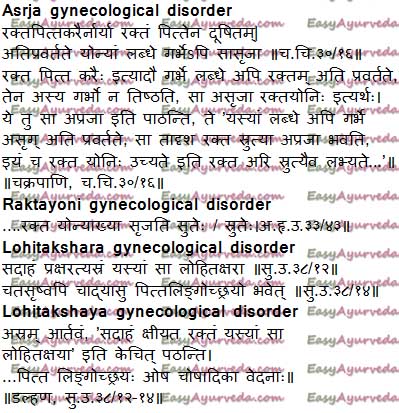Apraja – Raktayoni – Lohitakshara Symptoms, Causes, Treatment
By Dr Raghuram Y.S. MD (Ay) & Dr Manasa, B.A.M.S
Asrja is one among the 20 gynaecological disorders caused by vitiated pitta and blood. Different authors have explained the same condition using different names. While Master Charaka names it as Asrja / Apraja, both Vagbhatas name it as Raktayoni and Master Sushruta calls it Lohitakshara. Commentator Dalhana calls the same condition as lohita kshaya. Read – Rakta Pradoshaja Rogas – When Blood Is Vitiated By Doshas
Table of Contents
Asruj gynaecological disorder
Causative factors – Excessive consumption of foods which are capable of aggravating both pitta and blood
Pathogenesis – Blood situated in the reproductive organs get vitiated by pitta Read – Lifestyle, Food And Factors That Cause Pitta Dosha Increase
Symptoms –
- Bleeding from vagina even after conception – Asrja
- Excessive bleeding leads to abortion. Thus the woman remains without a progeny. Therefore it is called as apraja. Apraja = Na + Praja i.e. No Progeny. (Chakrapani)
- Excessive bleeding from vagina – Raktayonim Read – Bleeding During Pregnancy: Causes, Ayurvedic Treatment
Raktayoni gynaecological disorder
Rakta = blood Yoni = vagina
Raktyoni is a gynaecological disorder characterised by excessive bleeding from vagina Read – Heavy Periods, Menstrual Bleeding: Ayurvedic Treatment
Lohitakshara gynaecological disorder
This codition is characterized by –
- Excessive bleeding or oozing of blood from vagina associated with burning sensation, excessive oozing of blood due to vitiation of blood and burning sensation due to vitiation of pitta, both symptoms coexist due to simultaneous vitiation of both pitta and blood
- Other symptoms of pitta vitiation including local suppuration, increased heat and burning sensation in the genital organs etc
- Fever is also present as a generalised symptom due to vitiation of pitta
Lohitakshaya gynaecological disorder
Commentator Dalhana has named the same condition as Lohitakshay.
Lohita = blood Kshaya = deficiency
He opines that as there is severe loss of menstrual blood in this disease, there will be loss of blood. Therefore this condition is called lohitakshayam. Read – Hypomenorrhoea: Causes, Remedies, Ayurvedic Treatment
Sanskrit verse

Modern correlation
Modern correlation and comparative study
All the above conditions though named differently have almost similar presentation. All these are characterised with ‘excessive or irregular bleeding during menstruation’. Read – Physiology Of Menstruation, Menstrual Cycle – Ayurvedic Perspective
These conditions can be correlated with the below mentioned conditions –
1. Ovulatory / Non-ovulatory dysfunctional uterine bleeding (as per explanation of Charaka and Vagbhata)
Charaka and Vagbhata, both have mentioned excessive blood loss during menstruation as main feature of Asrjam / Apraja / Raktyoni gynecological disorders, in spite of naming them differently. Charaka’s Asrja means due to (ja) asr (blood) i.e. condition caused due to excessive bleeding.
Read – Menstrual Pain, Painful Periods – Natural Ayurvedic Herbal Home Remedies
Vagbhata’s Raktayonim also means excessive bleeding from vagina. Thus, the terms used to describe these conditions by both authors also mean the same.
In addition, Charka also mentions that there is excessive bleeding from vagina even after the conception has taken place. Thus Charaka’s explanation means that
- there is excessive vaginal bleeding during menstruation
- the bleeding also persists after conception
- which eventually causes abortion due to failure of implantation of zygote
- thus, the woman remains childless and therefore this condition is also called apraja
Read – Ayurvedic Diet And Lifestyle During Menstruation (Periods)
Why and how does this happen?
These conditions mainly happen due to ovulatory or non-ovulatory dysfunctional uterine bleeding. This is due to functional abnormalities of hypothalamus, pituitary and ovaries, i.e. disturbance of hypothalamus-pituitary-ovarian axis which maintains normal menstrual cycles in women. If the cycles are ovulatory, fertilization may occur, but implantation will not occur. This is because the endometrium will not be properly prepared to facilitate implantation of zygote, due to lack of adequate hormonal support. Read – Essential Elements For Conception – Garbha Sambhava Samagri
2. Cervical erosion with ulcer / Cervical polyps (as per explanation of Sushruta)
In small cervical polyps or erosion of cervix with ulcers, intermittent scanty bleeding / blood stained discharges are evident. This resembles ‘oozing of blood’ explained by Sushruta in the context of lohitakshara. Since the erosion will be associated with chronic inflammation, features like burning sensation etc will also be present. Irregular bleeding can also be noted in case of cervical polyps. Read – Somaroga – Excessive Female Discharge With Loss Of Vitality
Treatment of Asrjam / Raktayoni
Rakta sthapana aushadham / Haemostatic treatment – after determining the association of specific doshas on the basis of colour of excreted blood, haemostatic treatment should be done. While administering haemostatic treatment, the vitiated doshas in blood should be considered. Read – Treatment Principles Of Raktapitta – Bleeding Disorders
Uttara basti / intra-vaginal enema with Kashmaryadi ghrita – Ghee processed with Stereospermum suaveolens and Holarrhena antidysenterica should be used for giving enema through vaginal route, into the uterus.
Rakta Uttara Basti / intra-vaginal enema using medicated blood – Blood of deer, goat, sheep and hog mixed with sour substances, curds, honey and should be administered into the uterus through vagina.
Medicinal Yogas for Pradara From Sahasra Yoga Text Book
Raktapittahara Kashaya
Pradarahara Kashaya
Swetapradarahara Kashaya
Asrigdarahara Kashaya
Tiktaka Ghrita
Mahatiktaka Ghrita
Dhatryadi Ghrita
Modaka Twagadi Ghrita
Maha Kushmanda Ghrita
Chandanadi Taila
Pushyanuga Choorna
Sarasija makarandadi Choorna
Viswailadi Choorna
Asokarishta
Patrangasava
Kushmanda Rasayana
Satavari Guda
Kautajadi Guda
Kousa Mushtabhayadi Kashaya
Vasadi Kashaya
Pathyamalakhyadi Kashaya
Tengin Pukkuladi Ghrita
Click to Consult Dr Raghuram Y.S. MD (Ayu) – Email / Skype








